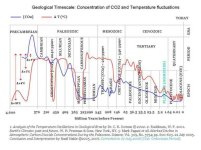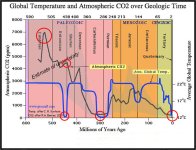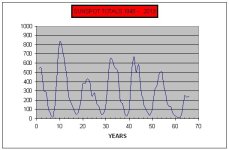You are using an out of date browser. It may not display this or other websites correctly.
You should upgrade or use an alternative browser.
You should upgrade or use an alternative browser.
Global Warming
- Thread starter Bill Gammon
- Start date
well it isn't shirt sleeve weather here in Wisconsin, 1 snow fall 3 weekends ago wasn't much - melted . lows in the teens -20's highs in 30-40 range depending on where you are in the state. Enjoy it will turn White soon enough. Once that happens the highs will maybe 20 and lows in the 0 or less class.
In Wisconsin it possible to have all 4 seasons in one day.
In Wisconsin it possible to have all 4 seasons in one day.
vtmarmot
P Magoon, Livin' Free NH
What's normal weather depends upon your time frame. Here in sunny New England, I like to remind people that "normal" for wherever we're standing is 2 miles of ice, over the last few million years anyhow, and we're just at the tail end of a little 14,000 year interlude. The average inter-ice-age interlude for the last 20 or so ice ages is something like 10,000 years, so we're on borrowed time. Another fun fact, just before each ice age, you get a warming spike, then it's down in the deep freeze for another 100,000 years. When it happens, it happens quick. It just starts snowing, and it doesn't stop. That actually happened about 5,000 years ago in a micro-climate in the alps, and the area just thawed out a few years ago. They found evidence of early stone-age industrial sites abandoned with tools left laying around when it started snowing. Whole forests got covered and they're just now being revealed.
The alarmists like Bill McKibben get all frothy at the mouth about a few degrees swing here or there. When you look at the geologic and ice core record, things look a lot different. Even within living memory you've had some bizarre weather. New England had the disastrous 1927 flood followed closely by the calamitous 1936 hurricane. If today's "climatologists" had been alive then, they'd have been predicting imminent doom. People back then took it in stride.
I read a book called "200 Years of Vermont Weather". It was an eye-opener. As far as extremes go, we ain't seen nothin' in our lifetimes unless we're in our 90's.
The alarmists like Bill McKibben get all frothy at the mouth about a few degrees swing here or there. When you look at the geologic and ice core record, things look a lot different. Even within living memory you've had some bizarre weather. New England had the disastrous 1927 flood followed closely by the calamitous 1936 hurricane. If today's "climatologists" had been alive then, they'd have been predicting imminent doom. People back then took it in stride.
I read a book called "200 Years of Vermont Weather". It was an eye-opener. As far as extremes go, we ain't seen nothin' in our lifetimes unless we're in our 90's.
JerrySharrett
Senile Member
Bill, we had a high of 68f yesterday with a forecast high of next Wednesday of 40f. Thus proving our weather is almost predictable as LT32 powder lots!!
Question- are Sanctuary cities like SF any more predictable with all the hot blooded southern border intruders like the slime the SF courts just turned loose? Go frigger!!
.
Question- are Sanctuary cities like SF any more predictable with all the hot blooded southern border intruders like the slime the SF courts just turned loose? Go frigger!!
.
Wayne Shaw
Active member
You're on a roll Jerry!
A quote from a physicist acquaintance of mine...
"We live on an active planet."
What's normal weather depends upon your time frame. Here in sunny New England, I like to remind people that "normal" for wherever we're standing is 2 miles of ice, over the last few million years anyhow, and we're just at the tail end of a little 14,000 year interlude. The average inter-ice-age interlude for the last 20 or so ice ages is something like 10,000 years, so we're on borrowed time. Another fun fact, just before each ice age, you get a warming spike, then it's down in the deep freeze for another 100,000 years. When it happens, it happens quick. It just starts snowing, and it doesn't stop. That actually happened about 5,000 years ago in a micro-climate in the alps, and the area just thawed out a few years ago. They found evidence of early stone-age industrial sites abandoned with tools left laying around when it started snowing. Whole forests got covered and they're just now being revealed.
The alarmists like Bill McKibben get all frothy at the mouth about a few degrees swing here or there. When you look at the geologic and ice core record, things look a lot different. Even within living memory you've had some bizarre weather. New England had the disastrous 1927 flood followed closely by the calamitous 1936 hurricane. If today's "climatologists" had been alive then, they'd have been predicting imminent doom. People back then took it in stride.
I read a book called "200 Years of Vermont Weather". It was an eye-opener. As far as extremes go, we ain't seen nothin' in our lifetimes unless we're in our 90's.
"We live on an active planet."
Going to be 12deg high and -7 for low mid week in Wisconsin plus some snow flurries- course those flurries could become one heck of a storm ( seen that before) and I have seen these kind of temps in Dec many times before.
Yep. Bill is benefiting from the Local NUKE Plant....Vera Carter works there........
Andy Cross
New member
My take on it
My take on global warming goes like this. The story of the earth is written in the rocks and ice layers. It's been a lot warmer than it is now and what's predicted. To the point of where for a while it was almost uninhabitable. It will cool down again as well. This warming cycle began about 20 thousand years ago when the effect took us out of an ice age. I am pretty sure it wasn't an industrial revolution of some sort that initiated it. What humans have done might speed the process up a little and the maximum effect might be a little more severe than it might have been.
But I am glad we are in a warming cycle because at the coldest in the last ice age it would have been difficult to grow food north of the tropic of cancer or south of the tropic of capricorn. I read in a journal somewhere that about every 2.5 million years or so a dominant species on earth becomes extinct. I think we could be classified as being dominant and according to the experts we are in that window now. I might go and have another shot of this nice single malt before it happens.
My take on global warming goes like this. The story of the earth is written in the rocks and ice layers. It's been a lot warmer than it is now and what's predicted. To the point of where for a while it was almost uninhabitable. It will cool down again as well. This warming cycle began about 20 thousand years ago when the effect took us out of an ice age. I am pretty sure it wasn't an industrial revolution of some sort that initiated it. What humans have done might speed the process up a little and the maximum effect might be a little more severe than it might have been.
But I am glad we are in a warming cycle because at the coldest in the last ice age it would have been difficult to grow food north of the tropic of cancer or south of the tropic of capricorn. I read in a journal somewhere that about every 2.5 million years or so a dominant species on earth becomes extinct. I think we could be classified as being dominant and according to the experts we are in that window now. I might go and have another shot of this nice single malt before it happens.
Lawrence W.
Member
Just like I approach my Benchrest. I don't listen to all the theories on loading, I believe what shows up on the target.

It seems that when viewed over the past 600 million years the atmospheric content of CO2 and the temperature are not linked as the Climate alarmist would have you believe. Secondly, the average temperature has been several degrees higher. Thirdly, even with 40 times the concentration of CO2 as we are seeing today, the temperature was only 3.5 degrees C hotter than today. So much for CO2 turning the earth into an uninhabitable desert!
This is my favorite least talked about report.
https://www.nasa.gov/feature/goddard/2016/carbon-dioxide-fertilization-greening-earth
It seems according to NASA that in the past 30 years the vegetation load on earth has increased by 14%. It turns out that the plants like the extra CO2 in the atmosphere and are growing like crazy. In my mind a greener earth is a healthier earth!
When testing a theory, please remember to always look at the results.

It seems that when viewed over the past 600 million years the atmospheric content of CO2 and the temperature are not linked as the Climate alarmist would have you believe. Secondly, the average temperature has been several degrees higher. Thirdly, even with 40 times the concentration of CO2 as we are seeing today, the temperature was only 3.5 degrees C hotter than today. So much for CO2 turning the earth into an uninhabitable desert!
This is my favorite least talked about report.
https://www.nasa.gov/feature/goddard/2016/carbon-dioxide-fertilization-greening-earth
It seems according to NASA that in the past 30 years the vegetation load on earth has increased by 14%. It turns out that the plants like the extra CO2 in the atmosphere and are growing like crazy. In my mind a greener earth is a healthier earth!
When testing a theory, please remember to always look at the results.
John Kielly
Shari's fan club
Careful now. Remember that 40% of your fellow Americans believe that the earth was created 9000 or so years a go, plus or minus.It seems that when viewed over the past 600 million years .........
To fully understand global warming, it helps to personalize it.
Ole was a bachelor farmer living in North Dakota, just a few hundred yards from the South Dakota border. One day, a group of Government surveyors representing the Public Land Survey System stopped by his humble farmstead. They explained to Ole that when the border between North and South Dakota was surveyed prior to their admittance into the Union on Nov. 2, 1889, a mistake had been made in one section of the border.
You guessed it, the mistake was right where Ole's 80 acres happened to be. As simply as they could, the dutiful public servants explained to Ole that the boundary had now been redrawn. The only real change was that Ole was now a resident of South Dakota rather than North Dakota.
Asked if he had any questions or comments, Ole rubbed his chin, slowly lit his pipe and said: "Good. No more of those damn cold North Dakota winters."
Ole was a bachelor farmer living in North Dakota, just a few hundred yards from the South Dakota border. One day, a group of Government surveyors representing the Public Land Survey System stopped by his humble farmstead. They explained to Ole that when the border between North and South Dakota was surveyed prior to their admittance into the Union on Nov. 2, 1889, a mistake had been made in one section of the border.
You guessed it, the mistake was right where Ole's 80 acres happened to be. As simply as they could, the dutiful public servants explained to Ole that the boundary had now been redrawn. The only real change was that Ole was now a resident of South Dakota rather than North Dakota.
Asked if he had any questions or comments, Ole rubbed his chin, slowly lit his pipe and said: "Good. No more of those damn cold North Dakota winters."
Maunder Minimum
I have been following this thread with interest as is affects us all.
However, can the mighty sun be of more influence than the paranoid greenoid climatoids give credit to?
Just a few hundred years ago the planet suffered a mini ice age - it was not man-made.
Check out such sites as this one http://joannenova.com.au/2011/05/the-brutal-cold-of-the-maunder-minimum-and-the-great-irish-frost/ it's quite educational.
Also events such as this were quite popular http://www.historic-uk.com/HistoryUK/HistoryofEngland/The-Thames-Frost-Fairs/
So who got the blame for all this?
Regards from Australia * doghunter *
I have been following this thread with interest as is affects us all.
However, can the mighty sun be of more influence than the paranoid greenoid climatoids give credit to?
Just a few hundred years ago the planet suffered a mini ice age - it was not man-made.
Check out such sites as this one http://joannenova.com.au/2011/05/the-brutal-cold-of-the-maunder-minimum-and-the-great-irish-frost/ it's quite educational.
Also events such as this were quite popular http://www.historic-uk.com/HistoryUK/HistoryofEngland/The-Thames-Frost-Fairs/
So who got the blame for all this?
Regards from Australia * doghunter *
Just like I approach my Benchrest. I don't listen to all the theories on loading, I believe what shows up on the target.
View attachment 20422
It seems that when viewed over the past 600 million years the atmospheric content of CO2 and the temperature are not linked as the Climate alarmist would have you believe. Secondly, the average temperature has been several degrees higher. Thirdly, even with 40 times the concentration of CO2 as we are seeing today, the temperature was only 3.5 degrees C hotter than today. So much for CO2 turning the earth into an uninhabitable desert!
This is my favorite least talked about report.
https://www.nasa.gov/feature/goddard/2016/carbon-dioxide-fertilization-greening-earth
It seems according to NASA that in the past 30 years the vegetation load on earth has increased by 14%. It turns out that the plants like the extra CO2 in the atmosphere and are growing like crazy. In my mind a greener earth is a healthier earth!
When testing a theory, please remember to always look at the results.
Having worked in space radiation effects on semiconductors charts like the one above always give me pause.
Notice there are NO error bars on the lines?
Failing to consider and account for known errors gives an unreasonable picture of what is (maybe) going on.
Proton testing of semiconductors is a nightmare.
It typically takes around 10,000 protons through the sensitive area of a part to have a single interaction that can be observed on part operation and functioning.
And once the satellite is in orbits in orbit it can see very widely varying proton rates.
Depending on the altitude and orbital path.
In the South Atlantic Anomaly
Add to that the areas over each pole from the magnetic field holding trapped protons.
And just because the protons are not interacting with the sensitive volume of the part does not mean they are not depositing radiation in other volumes.
We had a new part fail on orbit in less than one orbit.
When tested we found a very tiny sensitive area in the part that allowed a current source transistor to burn out from a single proton strike.
The part continued to fail with events about every 2 years +/-3 weeks for over 8 years of time on orbit.
Four failures over 8 years each within 3 weeks of our prediction.
Our proprietary model of the proton belts, the SSA, and 'space weather' worked better than EVERY other model.
M
mks
Guest
Notice there are NO error bars on the lines?
Failing to consider and account for known errors gives an unreasonable picture of what is (maybe) going on.
And there is not even a SCALE on the CO2 curve! Good science is not reported this way.
Lawrence W.
Member
vtmarmot
P Magoon, Livin' Free NH
My favorite climate alarmist absurdity is "global warming due to human activity is settled science." This indicates complete ignorance of how science operates. Once, it was "settled science" that the earth is flat. As Charlie Daniels says, "How stupid do these people think we are?"
The "climatologists" are not content to let science work. They have to bludgeon everyone into agreeing with them or cause them to be ostracized.
The "climatologists" are not content to let science work. They have to bludgeon everyone into agreeing with them or cause them to be ostracized.





